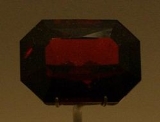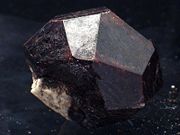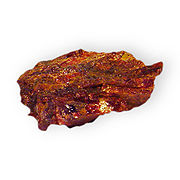
Pyrope
Encyclopedia
- This article is about the mineral. For the bird sometimes placed in the monotypic genus Pyrope, see Fire-eyed DiuconFire-eyed DiuconThe Fire-eyed Diucon is a passerine bird of South America belonging to the tyrant flycatcher family Tyrannidae. It is usually placed with the monjitas in the genus Xolmis but was sometimes placed in its own genus Pyrope in the past....
.
The mineral pyrope is a member of the garnet
Garnet
The garnet group includes a group of minerals that have been used since the Bronze Age as gemstones and abrasives. The name "garnet" may come from either the Middle English word gernet meaning 'dark red', or the Latin granatus , possibly a reference to the Punica granatum , a plant with red seeds...
group. Pyrope is the only member of the garnet family to always display red colouration in natural samples, and it is from this characteristic that it gets its name: from the Greek for fire and eye. Despite being less common than most garnets, it is a widely used gemstone
Gemstone
A gemstone or gem is a piece of mineral, which, in cut and polished form, is used to make jewelry or other adornments...
with numerous alternative names, some of which are misnomer
Misnomer
A misnomer is a term which suggests an interpretation that is known to be untrue. Such incorrect terms sometimes derive their names because of the form, action, or origin of the subject becoming named popularly or widely referenced—long before their true natures were known.- Sources of misnomers...
s. Chrome pyrope, and Bohemian garnet are two alternative names, the usage of the later being discouraged by the Gemological Institute of America
Gemological Institute of America
The Gemological Institute of America, or GIA, is a nonprofit institute dedicated to research and education in the field of gemology and the jewelry arts. Founded in 1931, GIA's mission is to protect all buyers and sellers of gemstones by setting and maintaining the standards used to evaluate...
. Misnomers include Colorado ruby, Arizona ruby, California ruby, Rocky Mountain ruby, Elie Ruby, Bohemian carbuncle, and Cape ruby.

Calcium
Calcium is the chemical element with the symbol Ca and atomic number 20. It has an atomic mass of 40.078 amu. Calcium is a soft gray alkaline earth metal, and is the fifth-most-abundant element by mass in the Earth's crust...
, Cr
Chromium
Chromium is a chemical element which has the symbol Cr and atomic number 24. It is the first element in Group 6. It is a steely-gray, lustrous, hard metal that takes a high polish and has a high melting point. It is also odorless, tasteless, and malleable...
, Fe
Iron
Iron is a chemical element with the symbol Fe and atomic number 26. It is a metal in the first transition series. It is the most common element forming the planet Earth as a whole, forming much of Earth's outer and inner core. It is the fourth most common element in the Earth's crust...
and Mn
Manganese
Manganese is a chemical element, designated by the symbol Mn. It has the atomic number 25. It is found as a free element in nature , and in many minerals...
. Pyrope forms a solid solution
Solid solution
A solid solution is a solid-state solution of one or more solutes in a solvent. Such a mixture is considered a solution rather than a compound when the crystal structure of the solvent remains unchanged by addition of the solutes, and when the mixture remains in a single homogeneous phase...
series with almandine
Almandine
Almandine , also known incorrectly as almandite, is a species of mineral belonging to the garnet Group. The name is a corruption of alabandicus, which is the name applied by Pliny the Elder to a stone found or worked at Alabanda, a town in Caria in Asia Minor. Almandine is an iron alumina garnet,...
and spessartine
Spessartine
Spessartine previously named spessartite, is a nesosilicate, manganese aluminium garnet species, Mn3Al23.The name is a derivative of Spessart in Bavaria, Germany, the type locality of the mineral. It occurs most often in granite pegmatite and allied rock types and in certain low grade metamorphic...
, which are collectively known as the pyralspite garnets (pyrope, almandine, spessartine). Iron and manganese substitute for the magnesium in the pyrope structure. The resultant, mixed composition garnets are defined according to their pyrope-almandine ratio. The semi-precious stone rhodolite
Rhodolite
Rhodolite is a varietal name for rose-pink to red mineral pyrope, a species in the garnet group. It is found in Cowee Valley, Macon County, North Carolina. The name is derived from the Greek for "rose-like", in common with many pink mineral types , but rhodolite itself is not officially recognised...
is a garnet of ~70% pyrope composition.
The origin of most pyrope is in ultramafic rocks, typically peridotite
Peridotite
A peridotite is a dense, coarse-grained igneous rock, consisting mostly of the minerals olivine and pyroxene. Peridotite is ultramafic, as the rock contains less than 45% silica. It is high in magnesium, reflecting the high proportions of magnesium-rich olivine, with appreciable iron...
from the Earth's mantle: these mantle-derived peridotites can be attributed both to igneous and metamorphic
Metamorphic rock
Metamorphic rock is the transformation of an existing rock type, the protolith, in a process called metamorphism, which means "change in form". The protolith is subjected to heat and pressure causing profound physical and/or chemical change...
processes. Pyrope also occurs in ultrahigh-pressure (UHP) metamorphic rocks, as in the Dora-Maira massif in the western Alps. In that massif, nearly pure pyrope occurs in crystals to almost 12 cm in diameter; some of that pyrope has inclusions of coesite
Coesite
Coesite[p] is a form of silicon dioxide SiO2 that is formed when very high pressure , and moderately high temperature , are applied to quartz. Coesite was first synthesized by Loring Coes, Jr., a chemist at the Norton Company, in 1953. In 1960, coesite was found by Edward C. T...
, and some has inclusions of enstatite
Enstatite
Enstatite is the magnesium endmember of the pyroxene silicate mineral series enstatite - ferrosilite . The magnesium rich members of the solid solution series are common rock-forming minerals found in igneous and metamorphic rocks...
and sapphirine
Sapphirine
Sapphirine is a rare mineral, a silicate of magnesium and aluminium with the chemical formula 86O20 . Named for its sapphire-like colour, sapphirine is primarily of interest to researchers and collectors: well-formed crystals are treasured and occasionally cut into gemstones...
.
Pyrope is common in peridotite
Peridotite
A peridotite is a dense, coarse-grained igneous rock, consisting mostly of the minerals olivine and pyroxene. Peridotite is ultramafic, as the rock contains less than 45% silica. It is high in magnesium, reflecting the high proportions of magnesium-rich olivine, with appreciable iron...
xenoliths from kimberlite
Kimberlite
Kimberlite is a type of potassic volcanic rock best known for sometimes containing diamonds. It is named after the town of Kimberley in South Africa, where the discovery of an diamond in 1871 spawned a diamond rush, eventually creating the Big Hole....
pipes, some of which are diamond
Diamond
In mineralogy, diamond is an allotrope of carbon, where the carbon atoms are arranged in a variation of the face-centered cubic crystal structure called a diamond lattice. Diamond is less stable than graphite, but the conversion rate from diamond to graphite is negligible at ambient conditions...
-bearing. Pyrope found in association with diamond commonly has a Cr2O3 content of 3-8%, which imparts a distinctive violet to deep purple colouration (often with a greenish tinge) and because of this is often used as a kimberlite indicator mineral in areas where erosive activity makes pin pointing the origin of the pipe difficult. These varieties are known as chrome-pyrope, or G9/G10 garnets.
Mineral identification

Mafic
Mafic is an adjective describing a silicate mineral or rock that is rich in magnesium and iron; the term is a portmanteau of the words "magnesium" and "ferric". Most mafic minerals are dark in color and the relative density is greater than 3. Common rock-forming mafic minerals include olivine,...
and ultramafic minerals may be the best indication that the garnet you are studying is pyrope.
In petrographic
Petrography
Petrography is a branch of petrology that focuses on detailed descriptions of rocks. Someone who studies petrography is called a petrographer. The mineral content and the textural relationships within the rock are described in detail. Petrographic descriptions start with the field notes at the...
thin section
Thin section
In optical mineralogy and petrography, a thin section is a laboratory preparation of a rock, mineral, soil, pottery, bones, or even metal sample for use with a polarizing petrographic microscope, electron microscope and electron microprobe. A thin sliver of rock is cut from the sample with a...
, the most distinguishing features of pyrope are those shared with the other common garnets: high relief and isotropy. Garnets tend to be less strongly coloured than other silicate minerals in thin section, although pyrope may show a pale pinkish-purple hue in plane-polarized light. The lack of cleavage, commonly euhedral crystal morphology, and mineral associations should also be used in identification of pyrope under the microscope.
Health effects
Magnesium aluminum silicate powder is a common ingredient in makeup, pesticide, pharmaceuticals, and other products. Specific health effects depend upon the size, shape, and amount when dust particles are lofted into the air. Fine powder forms clay when water is added. Studies do not exist that indicate increase risk of cancer.Magnesium aluminum silicate is not considered to be a hazardous substance by US Department of Transportation and US Environmental Protection Agency, and it is not considered to be carcinogenic under California Proposition 65.
Aluminum is one of the non-protein components of amyloid plaque associated with Alzheimer's disease. Silicon is associated with increase risk of cancer and osteoporosis. Magnesium aluminum silicate contains both.
Do not breathe dust. If ingested, seek medical advice immediately and display the container or label to physicians. Respirators are required to prevent inhalation. The treatment after inhalation is to keep airways open and provide oxygen. A self contained breathing apparatus should be used to avoid dust inhalation.
The following are required for large spills.
- Splash goggles.
- Full suit.
- Dust respirator.
- Boots.
- Gloves.
There are several forms, and magnesium aluminum silicate may be identified by several different CAS#, such as 12174-11-7, 1327-43-1, and 12199-37-0.
Inhaling finely divided dust particles in very small quantities over time can lead to bronchitis
Bronchitis
Acute bronchitis is an inflammation of the large bronchi in the lungs that is usually caused by viruses or bacteria and may last several days or weeks. Characteristic symptoms include cough, sputum production, and shortness of breath and wheezing related to the obstruction of the inflamed airways...
, emphysema
Emphysema
Emphysema is a long-term, progressive disease of the lungs that primarily causes shortness of breath. In people with emphysema, the tissues necessary to support the physical shape and function of the lungs are destroyed. It is included in a group of diseases called chronic obstructive pulmonary...
, or other diseases as the dust becomes lodged in the lungs, reducing lung capacities. In the body, magnesium aluminum silicate particles dissolve slowly and may form mud, which may be expectorated from the lungs and ingested. This exposes the body to silicon and aluminum that can pose health risks. Children, asthmatics of any age, allergy sufferers, and the elderly (all of whom have reduced lung capacity) can be affected in much less time.
Names
The following names may be used to describe silica dust.| Aluminosilicic acid, magnesium salt | Magnesium Aluminometasilicate | Attapulgite |
| Magnesium Aluminum Silicate Type 1A | Smectite Clay | Palygorskite |
| SAluminum Magnesium Silcate Type 1A | Veegum | Pyrope |
Inhalation Risks
- Alzheimer's: Respirable and ingested magnesium aluminum silicate may contribute to Alzheimer's disease.
- Osteoporosis: Respirable and ingested magnesium aluminum silicate may contribute to osteoporosis.
- Non-Malignant Respiratory Diseases (other than silicosis): Some studies show an increased incidence of chronic bronchitis and emphysema associated with magnesium aluminum silicate

